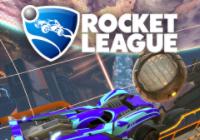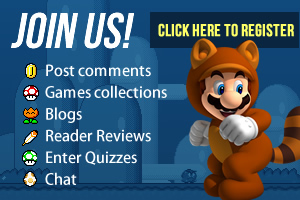Rocket League (Nintendo Switch) Review
By Az Elias  25.11.2017
25.11.2017

It is crazy to think that Rocket League is a sequel to another game. Psyonix's ridiculous blend of playing association football in mini arenas with remote-controlled cars took off like no one could have predicted in 2015, but the developer had attempted it all before in 2008's PlayStation 3 title Supersonic Acrobatic Rocket-Powered Battle-Cars. Whether it was the absurdly long name or the slightly more complicated style that caused the original game to be completely overlooked at large, it may never be known, but thank goodness Psyonix gave their whacky idea another go, because Rocket League is some of the finest and entertaining multiplayer around, gearing up for more on Nintendo Switch.
Absolutely crucial for Rocket League to function properly is to play at 60 frames per second. This was always a goal for Psyonix when co-operating with Panic Button to bring this massively popular sporting game to the Switch, and whilst there have been graphical cutbacks to guarantee this, the sacrifices are worth it.
If you are familiar with Rocket League already, it plays just as good here as anywhere else, and you will be up and running in no time, boosting, flipping and banging goals into the back of the net like you have before on other platforms. It is remarkable just how great it feels, and, honestly, the visual downgrades aren't much to fuss over. Some of the higher effects are absent, such as fine grass movement, which is highly noticeable on the title screen, and, yes, to be fair, the game can at times look jaggy when looking into the distant end of an arena, with blocky cars and footballs, but for the most part, this is perfectly viewable.

There are definitely some unfortunate moments on the visual spectrum, however, usually after resuming the game from a pause, or during the first seconds after joining a match, but it irons itself out shortly after. Handheld mode is where it might seem worse, but again, it's rarely a problem in terms of being able to see exactly what is going on. If it's a choice of accepting these graphical setbacks (with the game still looking great, just notably more dull) and maintaining 60fps versus the opposite, there is only one winner here.
Rocket League owes its mainstream appeal to how easy it is to get into. Stripping the game back to simple arenas with no gimmicks, unlike the original PS3 title, makes way for a game anyone can pick up and play and know exactly what to do. Variations over the traditional soccer format exist, such as the slippery ice hockey or basketball hoops modes, and there is even a Mario Kart-esque style featuring power-ups for those who want to add a little more of a party theme to the goal scoring fun. As in previous versions, mutators allow for huge customisation in matches, from altering the shape, size and weight of the ball to gravity and boost settings. For local multiplayer, the ability to really twist things up keeps the game from growing too stale, and gives less experienced players more of a chance.
Aside from a single-player season with difficulty settings, the core of Rocket League is still in the online play, featuring ranked and unranked matches that range from 1V1 and up to 4V4. Given the cross-play between Switch, Xbox One and PC players that is available, you can be sure that there are always going to be people online to play with and against. The downside right now is that there is very much a chance of being matched against some expert players on other platforms as you look to find your suitable ranking division, which moves you up and down based on results.

Although natural to get to grips with, the extremely high skill ceiling means there is constant room to get better. Whilst it can be very difficult to learn to "fly" and develop a decent aerial game, there are specialised player-created training regimes (on top of the drills already built in) that really help to get certain parts of your game tuned up in an attempt to compete with the big players. With these schemes, great effort has gone into helping struggling players, with plenty of drills that look to develop shooting, defending, goalkeeping, and tricky air play.
It can be easy to get annoyed and give up when being matched with flying pros online, but stick with it and try to find groups of players of your skill level if you cannot make that jump to the next level. The divisions in ranked do try to pit you with like-levelled players over time, and right now at least, there are more new users in the same position having picked up the Switch version. Remember that cross-play matchmaking can also be turned off in an attempt to match only with Switch users, too. As a related downside, it being impossible to invite and create a party between different platform friends is unfortunate, but is likely to be quite tough to implement, which is understandable.

Perfect for tabletop multiplayer, single Joy-Con work well for Rocket League, although the design can sometimes mean a tendency to go for the A button to accelerate as in Mario Kart through habit, instead of using the shoulder buttons. Despite missing a second control stick for camera control, all essential buttons are here, so quick matches can easily be thrown down when a couple of pals have got a few moments to spare.
Plenty of unlockables are in here, earned generally from playing matches, although it's very unfortunate that Rocket League has adopted the controversial loot box set-up. Crates can sometimes be rewarded after play, but it is impossible to open them without purchasing keys to do so. The possible contents can be seen beforehand, but what you get will be randomly selected. A huge shame, because some of the best stuff in terms of goal explosions, boost effects, wheel alloys, cars, paintjobs, and much more are tucked away in these crates, obtainable only by chance after forking up the cash. Where these would have previously been download content in their own right for a small sum in a not-so-distant past, they are now used as gamble prizes. The only positive is that gameplay skill isn't tied to stat boosts from loot boxes at all, unlike other current controversial games.
In a lovely little gift for Switch players, though, Pysonix has worked with Nintendo to design some great exclusive battle-cars based on Mario, Luigi and Samus Aran. Complete with special sound effects and boosts, there is no question Samus' Gunship vehicle is the best of the lot, with a sweet engine noise reminiscent of her actual hovering spacecraft. Not to sound too greedy, but some smaller extras would have been great, such as hats and antennas from other Nintendo characters and games. Maybe even some Rocket League-style Nintendo tune remixes to add to the already addictive soundtracks. What is added here is solid, though.

Cubed3 Rating
Great - Silver Award

Rocket League is showing no signs of slowing down, and why should it? Psyonix's RC car-footie combo is an esports favourite, and now even more players can see what the fuss is all about on Nintendo Switch. A visual downgrade is acceptable given that this plays exactly the same as the other versions, with cross-play to ensure the pool of opponents remains large online. A strong recommendation for any Switch owner - even for those who have it on another platform! After all, what Rocket League fan wouldn't want to train and match up on the go?
Comments
Comments are currently disabled

 Sign In
Sign In Game Details
Game Details
 Out now
Out now  Out now
Out now  Out now
Out now  Out now
Out now  Subscribe to this topic
Subscribe to this topic Features
Features







 Top
Top

